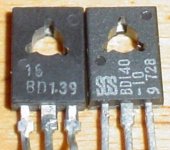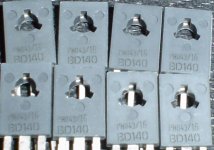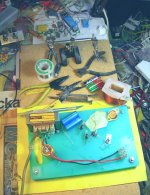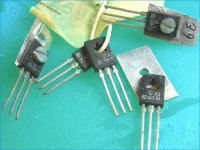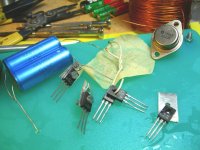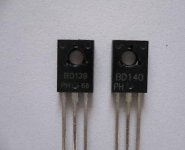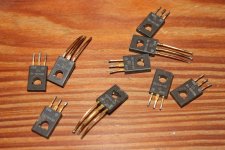It is really unlikely that most transistors are really identical to their nominal 10-20-30+ year old base part
the growth/diffusion equipment, wafer sizes, lithography, materials purity all have changed several generations since the original parts were made
ON Semi anounced an broad "die shrink" change in 2003 for many of these driver transistor types:
http://www.diyaudio.com/forums/showthread.php?postid=483282#post483282
the growth/diffusion equipment, wafer sizes, lithography, materials purity all have changed several generations since the original parts were made
ON Semi anounced an broad "die shrink" change in 2003 for many of these driver transistor types:
http://www.diyaudio.com/forums/showthread.php?postid=483282#post483282
I did some experimentation with oscillators
And back in 1976 or so, I would have to sort through 100s of 2n2219As and 2N2905A to find two that were matched. The JANTX2n2219A and -05A was the best because they were presorted. How can you buy presorted transistors now???? But this particular die was very fast and the oscillators would produce less waveform distortion with this transistor than most others because of C-B capacitance that controls switching times and I guess because of die geometry. I've just been out of it and want to upgrade my system. Just trying to find up to date, fast transistors. Thanks again. Ray
And back in 1976 or so, I would have to sort through 100s of 2n2219As and 2N2905A to find two that were matched. The JANTX2n2219A and -05A was the best because they were presorted. How can you buy presorted transistors now???? But this particular die was very fast and the oscillators would produce less waveform distortion with this transistor than most others because of C-B capacitance that controls switching times and I guess because of die geometry. I've just been out of it and want to upgrade my system. Just trying to find up to date, fast transistors. Thanks again. Ray
Defintely OLD ... They're lower voltage VCE cousins the BD137/138 are listed in my Mullard pocket data book dated 1970.
Mullard was the British components division of Philips after being bought out in the 1920s. Philips continued to use the Mullard name until 1988 in the UK. In 2006, Philips spun off and sold the majority of its business sharesin Philips semicondictors to NXP. So you may see all 3 names associated with the same semiconductor products.
Mullard was the British components division of Philips after being bought out in the 1920s. Philips continued to use the Mullard name until 1988 in the UK. In 2006, Philips spun off and sold the majority of its business sharesin Philips semicondictors to NXP. So you may see all 3 names associated with the same semiconductor products.
Re: Thanks for all the suggestions!
BC639 / BC640 are TO-92 versions of
BD139 / BD140
But of course TO-92 can not take as MUCH Heat/ temperature
as can one TO-126.
If you want modern SMT versions of BC639/BC640
for 80 Volt Collector Emitter,
check out these data sheets at Philips Website http://www.nxp.com/

BCP-53 and BCP-56
BCX-53 and BCX-56

You will also find Spice + Saber Models for those:
http://www.nxp.com/models/
If you make maximal good mounting for cooling,
these small SMT transistors can take close to 1 Watt.
PRODUCT PAGES:
http://www.nxp.com/pip/BC639.html
BC639; BCP56; BCX56
80 V, 1 A NPN medium power transistor series
http://www.nxp.com/pip/BC640.html
BC640; BCP53; BCX53
80 V, 1 A PNP medium power transistors
 Lineup Audio Lab
Lineup Audio Lab 
SemiConductors Information & Knowledge
since 1985 ( 22 years! )
Regards
lineup
grhughes said:Any special advice for heat sinking SOT89 transistors. The first transistor of a sziklai pair doesn't have to be heat sinked? I've never used SMT devices. I guess they have to lay flat?? Thanks, Ray
BC639 / BC640 are TO-92 versions of
BD139 / BD140
But of course TO-92 can not take as MUCH Heat/ temperature
as can one TO-126.
If you want modern SMT versions of BC639/BC640
for 80 Volt Collector Emitter,
check out these data sheets at Philips Website http://www.nxp.com/
BCP-53 and BCP-56
BCX-53 and BCX-56
You will also find Spice + Saber Models for those:
http://www.nxp.com/models/
If you make maximal good mounting for cooling,
these small SMT transistors can take close to 1 Watt.
PRODUCT PAGES:
http://www.nxp.com/pip/BC639.html
BC639; BCP56; BCX56
80 V, 1 A NPN medium power transistor series
http://www.nxp.com/pip/BC640.html
BC640; BCP53; BCX53
80 V, 1 A PNP medium power transistors
SemiConductors Information & Knowledge
since 1985 ( 22 years! )
Regards
lineup
Here's a pic: the one on the left is a Philips type, the second one a Thomson device.
Technology may have evolved in 20 years time, but 20 years ago the Philips BDs were very different from the others, as are the last production runs.
The Philips lab was amazing, i had one of the first pre-production CD100s in 1982/1983, (compliment of Philly Med. Systems), marketing never was their strongpoint.
Mullard tubes lives again, btw.
LineUp.
the ones on the pic i bought before 1985, guess i'm an ever bigger relic than you.
Technology may have evolved in 20 years time, but 20 years ago the Philips BDs were very different from the others, as are the last production runs.
The Philips lab was amazing, i had one of the first pre-production CD100s in 1982/1983, (compliment of Philly Med. Systems), marketing never was their strongpoint.
Mullard tubes lives again, btw.
LineUp.
the ones on the pic i bought before 1985, guess i'm an ever bigger relic than you.

Attachments
jacco vermeulen said:Finally managed to get a clear digital cam shot of last production Philips BD140 devices, tricky casing color, so here goes=>
thanks for you images, jacco
I have only a few of my BD139/140 supply.
Think they are all Philips.
At least when I bought them,
the big electronics supplier in North Europe http://www.elfa.se/
website in: Svenska Norsk Dansk Suomi Polski English
had a lot of (old) Philips semiconductors.
Now looks as they sell OSE OnSemi former Motorola versions ...
Are they okay?
Buy!
BD135/OSE 71-041-02 Info Datasheet 1.10 0.82 0.41 NPN E C B 12.5 45 1.5 40/250
BD136/OSE 71-036-58 Info Datasheet 0.97 0.45 0.32 PNP E C B 12.5 45 1.5 40/250
BD137/OSE 71-036-66 Info Datasheet 0.95 0.44 0.31 NPN E C B 12.5 60 1.5 40/250
BD138/OSE 71-036-74 Info Datasheet 0.96 0.45 0.32 PNP E C B 12.5 60 1.5 40/250
BD139/OSE 71-036-82 Info Datasheet 0.76 0.35 0.24 NPN E C B 12.5 80 1.5 40/250
BD140/OSE 71-042-35 Info Datasheet 1.03 0.76 0.38 PNP E C B 12.5 80 1.5 40/250
Below is result from my electronical corner of my room ( I live alone in 1 room + kitchen + bathroom)
Photo Session 15 minutes ago:
Lineup Audio Lab
Exhibition of BD139 BD140 stuff
Image #1:
Overview of a part of my working place, with those TO-126
Attachments
BD139 BD140 BUX39 - close up
.
here a close up
The pair, is a 'matched complementary' pair BD139 BD140
.. with my test figures on a paper attached with piece of wire.
Also can see some simple home made heatsinks
I use sometimes just in case.
I have bigger heatsinks for TO-126 TO-220 for 'hotter bias' applications, approaching temperture limit
Regards lineup
.
here a close up
The pair, is a 'matched complementary' pair BD139 BD140
.. with my test figures on a paper attached with piece of wire.
Also can see some simple home made heatsinks
I use sometimes just in case.
I have bigger heatsinks for TO-126 TO-220 for 'hotter bias' applications, approaching temperture limit
Regards lineup
Attachments
BUX39 and 200V

I still have a couple of those TO-3 big BUX39 left.
I bought 10 of them from a surplus sale, for almost nothing.
They are good for some heavier Currents non-Audio-amplifier things.
Those 2 caps are Polypropylene Axial:
marked: ERO KP1832, 200V=, 5%, 0.43uF
In upper right is a capture from A slaughter of old Transformator.
Enamelled copper wire is good for many things ....
in my little corner of my room company:
LIneup Audio Lab >>>> .. like 4 square meter. ( 2m x 2m )
But dont you go fool your selves, too much
- plenty of small goodies is too be found inside that little limited space of my life
Image #3 - my last for today.
I still have a couple of those TO-3 big BUX39 left.
I bought 10 of them from a surplus sale, for almost nothing.
They are good for some heavier Currents non-Audio-amplifier things.
Those 2 caps are Polypropylene Axial:
marked: ERO KP1832, 200V=, 5%, 0.43uF
In upper right is a capture from A slaughter of old Transformator.
Enamelled copper wire is good for many things ....
in my little corner of my room company:
LIneup Audio Lab >>>> .. like 4 square meter. ( 2m x 2m )

But dont you go fool your selves, too much
- plenty of small goodies is too be found inside that little limited space of my life
Image #3 - my last for today.
Attachments
Re: Thanks for all the suggestions!
 That's the whole idea behind surface mounted parts. Cooling SMT devices requires some considerations about the pcb.
That's the whole idea behind surface mounted parts. Cooling SMT devices requires some considerations about the pcb.
grhughes said:I've never used SMT devices. I guess they have to lay flat??
 That's the whole idea behind surface mounted parts. Cooling SMT devices requires some considerations about the pcb.
That's the whole idea behind surface mounted parts. Cooling SMT devices requires some considerations about the pcb.jacco vermeulen said:Back in the old days you had to open a semiconductor book to look at a datasheet, instead of clicking a pdf.
Of course, the semiconductor data book comes free if you've got a relative employed at the Philips NatLab in Eindhoven.
Free online datasheets often are abbreviated versions, sometimes saves you 10 to 14 pages.
A bunch of BD139/140s in parallel make a fantastic class A headphone amp output stage.
Philips versions are much nicer, Cob of 5.7pF, downside that the power they handle is 2/3d of the different die version.
Hello
Where did you find the Cob spec of the BD139 ?
I've never seen it in all versions of data sheets that I have.
Thank
Bye
Gaetan
They don't look like mine ... which were manufacted by Philips about 25 - 30 years ago ...
The ones I have have the printing of the type number on the bottom row closest to the pins ... not the next row up, like these. The three moulding dots are located close to the through hole, the edge is under 1 mm away, unlike these that have the moulding dots almost in the upper corners of the body.
The ones I have have the printing of the type number on the bottom row closest to the pins ... not the next row up, like these. The three moulding dots are located close to the through hole, the edge is under 1 mm away, unlike these that have the moulding dots almost in the upper corners of the body.
On top of what already was written by jacco, I would add that it is possible to check the capacitances of the device if you have a capacitance meter. If my memory serves me right, Philips BD140 would have B-C capacitance about 50-60pF at 0V, and ST etc. - about 100-120 pF. In any case the capacitances on BC640 and Philips BD140 (and their NPN complements BC639/BD139) are near identical.
x-pro
I just measured CoB capacitance of some BD's that I have at 0V for comparison.
ST BD139 50pF
No brand BD139 (PH402) 102pF
Philips BD139 30pF
Philips BD137 32pF
Harris BD137 22pF
No Brand (PH99) BD137 52pF
Philips BD140 52pF
Harris BD140 35pF
I find almost nothing about those Harris devices at internet. I look forward to find some info about their specs, especially Ft.
UPS!
I had not noticed this is a reopened older thread
but whatever, I measured my old Motorola BD139/140
not that I know much about how, but with diode function on my multimeter, I read 900...something
from one leg to other two, on all the shown devices
so I guess they are all ok ?
I had not noticed this is a reopened older thread
but whatever, I measured my old Motorola BD139/140
not that I know much about how, but with diode function on my multimeter, I read 900...something
from one leg to other two, on all the shown devices
so I guess they are all ok ?

Attachments
You must have a capacitance meter which able to measure in picofarads. You have to measure 2nd leg (Collector) and 3rd leg (Base) with capacitance meter for comparison.
If you want to know your transistors are working or not, just measure their HfE using a suitable multimeter. Many multimeters contain this feature rather than capacitance measurement.
If you want to know your transistors are working or not, just measure their HfE using a suitable multimeter. Many multimeters contain this feature rather than capacitance measurement.
- Status
- This old topic is closed. If you want to reopen this topic, contact a moderator using the "Report Post" button.
- Home
- Design & Build
- Parts
- BD139-16 & BD140-16? Anyone use these transistors?
